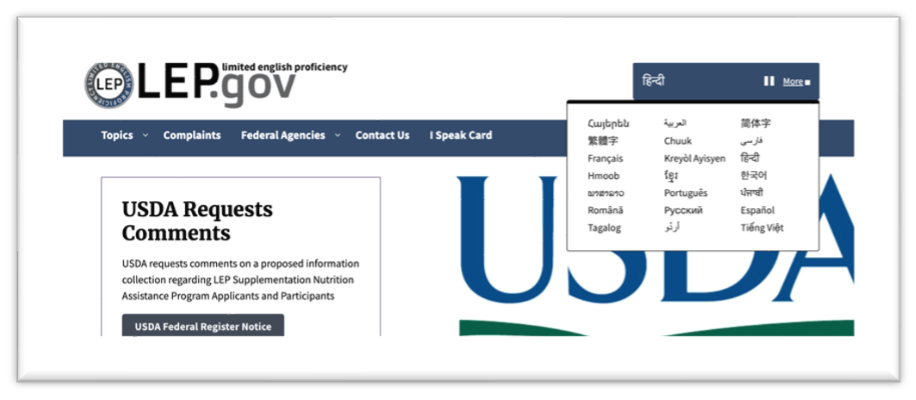Improve your Elections Office Web Translations
Elections office websites offer voters a wealth of information when it comes to understanding how to vote. The voting process for an English speaker is a different experience than for someone who’s a limited English proficient (LEP) speaker. The language difference can create barriers and cause people to give up without voting, leading to underrepresentation by LEP communities. In addition, while the Voting Rights Act requires language assistance to LEP individuals, “many voters may be unaware that they have a right to be assisted in casting a ballot and to bilingual election materials in many jurisdictions.”
If you’re going to invest in translating elections office materials, you’ll want to maximize the outreach of these materials. Part of the outreach is to make LEP communities aware of what you provide, starting with the elections website. In addition, the language access options must be super clear, so when an LEP individual goes to your website, that person can quickly see the content in their preferred language. This will contribute to a better investment for your funds and improve the voting journey for LEP individuals.
Tips for Translating Your Elections Office Website
A website is oftentimes the first place someone will go to get information. You need to translate and localize your website to reach LEP audiences. Here are some things to consider for your translation project.
1. Determine What Elections Office Materials to Translate
Ideally, you’d translate your entire elections office website. However, if you have a limited budget or time constraints, that may not be feasible. If you aren’t ready to translate your entire website, work with your LSP to determine the most vital pages and create a plan for the other pages.
2. Determine if You Should Include Locale-Specific Languages
Languages morph and evolve over time, leading to locale-specific variations of a language. For example, Hmong communities in California and Minnesota may generally use the core language, but variations will exist between the two variations. Learn more about language variations.
3. Use a Professional Language Service Provider (LSP), Not Google Translate
Machine translation is suitable for some types of content, such as content that isn’t critical or internal content, or for getting a general idea about something for a quick turnaround. However, you need a professional language service provider to provide the highest quality translations for something as critical as elections information. Election content can be tricky enough for an English speaker to understand, let alone someone who’s not proficient in English. You need to have a complete translation process that involves humans to translate election content.
Some of the other reasons why it’s not a good idea to use Google Translate for elections office materials include:
- Poor quality due to the nature of the content
- Google Translate can’t translate certain things like images or features with text
- Certain website features might not translate based on set up (like ads)
- It won’t update hyperlinks, so those will go to the source (English) content
4. Make Language Options Clear on the Elections Office Website
You can add some simple things to your elections office website to make language options clear and obvious for a visitor.
Create a Language Option
You want your visitors to know that there are language options, so you should have something that shows the options, whether it’s a dropdown selection or an entry button. Include a language option at the top of your webpage. It could look something like this:

It should be at the top of the page, because if a visitor doesn’t see it right away, that person may not know to scroll to look for it. For example, including all the languages in a footer is not a good option as people don’t tend to search for information like that in a footer, so it makes it hard to find.
Add a Universal Symbol to Denote Other Languages
In your language option, add a universal symbol (like a globe) to show that other languages are available. Also, include a dropdown someone can select the language that fits that person’s needs. You don’t want to use English words like “translate” to show that other languages are available.

Use the Translated Version of the Language
For the translated site language options, use the translated language name and not the English version. For example, use “Română” instead of “Romanian.” The English version of this language is “Romanian,” but those who speak Romanian use “Română.”
Maximize Awareness of Elections Office Translations
Section 203 of the Voting Rights Act requires that counties make election materials available to LEP individuals, so you want to make your target audiences know that you have information in different languages and that they have the right to these materials. Here are some ways to do that.
-
Add Content to the Elections Office Website We covered this in the previous section, but communicating language access through a website is necessary.
-
Use Other Online Channels for Election Materials Another way to get your message across is by using online outlets such as social media, influencing marketing, shared media, TV, radio, community websites, and other media outlets.
-
Create Printed Election Materials Creating and promoting onsite posters, flyers, and other hard-copy materials letting your target audiences know about their voting and language access rights is still a good way to communicate, as not everyone has access to a computer or the internet. And some organizations required hard-copy communications. You can share these with newspapers, organizations, and non-profits, as well as at community and cultural events.
Conclusion
Elections offices can improve voter turnout and the voting journey by providing website translations and outreach to the LEP community.
We have extensive experience in election translations and would love to help you with any aspect of the process. Learn more about our experience, and feel free to contact us at [email protected] or (530) 750-2040.